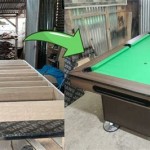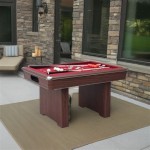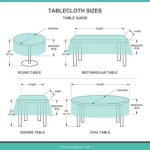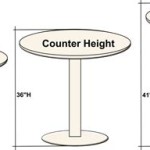The Allure and Practicality of Long Narrow Dining Table Sets
Long narrow dining table sets represent a strategic solution for maximizing space and enhancing the aesthetic appeal of dining areas, particularly in apartments, townhouses, and homes with limited width. These sets are designed to efficiently accommodate seating arrangements without overwhelming the room, offering a balance between functionality and stylish design. The configuration allows for communal dining experiences while retaining a sense of openness within the space.
The versatility of long narrow dining table sets lies in their adaptability to various interior design styles. From minimalist modern to rustic farmhouse, the market offers a wide range of materials, finishes, and styles that can seamlessly integrate into existing décor. Considerations such as the material of the table top (wood, glass, metal, or composite), the leg design (straight, tapered, trestle, or pedestal), and the accompanying chair style (upholstered, wooden, or metal) all contribute to achieving a cohesive and personalized dining space.
Beyond their space-saving attributes, long narrow dining table sets foster a sense of intimacy and connection among diners. The elongated shape encourages conversation and interaction, making them ideal for both casual family meals and formal dinner parties. The configuration also facilitates easy serving and access to dishes, further enhancing the dining experience.
Space Optimization and Layout Considerations
The primary advantage of a long narrow dining table set is its ability to optimize space in constrained dining areas. In apartments or smaller homes, where square footage is limited, a traditional square or round dining table can often feel bulky and impede traffic flow. A long narrow table, on the other hand, fits neatly against a wall or in a narrow dining room, allowing for comfortable seating without sacrificing valuable floor space. This efficient use of space can make a significant difference in the overall feeling of openness and comfort within the home.
When planning the layout for a long narrow dining table, several factors merit consideration. First, accurate measurements of the dining area are crucial to ensure the table fits comfortably with ample clearance for chairs and movement. A general rule of thumb is to allow at least 36 inches of space between the table and any walls or furniture. This clearance allows diners to easily pull out their chairs and walk around the table without feeling cramped.
The placement of the table within the room is also important. Consider the natural light sources and the location of doorways and walkways. Positioning the table near a window can create a more pleasant and inviting dining atmosphere. However, avoid placing the table directly in a high-traffic area, as this can be disruptive and uncomfortable for diners. In some cases, it may be beneficial to center the table under a chandelier or other overhead lighting fixture to create a focal point in the room.
Furthermore, the shape of the room itself may influence the optimal table size and placement. In a very narrow and long room, a table that runs lengthwise along the room may be the most logical choice. In a slightly wider room, it may be possible to position the table perpendicular to the long wall, creating a more balanced and visually appealing layout. Experimenting with different arrangements, using measuring tape and furniture templates, can help determine the most effective use of the available space.
Material Selection and Style Integration
The selection of materials for a long narrow dining table set plays a significant role in its durability, aesthetic appeal, and overall functionality. Wood, glass, metal, and composite materials are commonly used, each offering distinct characteristics and advantages. Solid wood tables, for example, are known for their warmth, natural beauty, and durability. They can be stained, painted, or left with a natural finish to complement various design styles. Hardwoods like oak, maple, and cherry are particularly durable and resistant to scratches and dents.
Glass-topped tables offer a sleek and modern aesthetic, creating a sense of lightness and openness in the dining area. Glass is also easy to clean and maintain, making it a practical choice for busy households. However, glass can be prone to fingerprints and smudges, requiring frequent cleaning. Additionally, glass tables may not be as durable as solid wood tables and can be susceptible to chipping or breaking.
Metal tables, often made of steel or iron, offer a contemporary and industrial-chic aesthetic. Metal is incredibly durable and resistant to damage, making it a good choice for high-traffic areas or homes with children and pets. Metal tables can be paired with wooden or upholstered chairs to create a balanced and visually interesting look. However, metal can feel cold and impersonal, and may require the addition of warmer elements, such as rugs or textiles, to create a more inviting atmosphere.
Composite materials, such as laminate or engineered wood, offer a cost-effective alternative to solid wood. These materials can mimic the look of wood or other natural materials while being more resistant to scratches, stains, and moisture. Composite tables are also generally lighter than solid wood tables, making them easier to move and assemble. However, composite materials may not be as durable as solid wood and may not have the same inherent beauty and character.
The style of the dining table should also complement the overall design aesthetic of the home. A minimalist modern dining room may benefit from a sleek glass-topped table with metal legs and simple, unadorned chairs. A rustic farmhouse dining room, on the other hand, may be better suited to a solid wood table with a distressed finish and ladder-back chairs. Choosing a table and chairs that are consistent with the existing décor will create a cohesive and harmonious dining space.
Chair Selection and Ergonomic Considerations
The choice of chairs that accompany a long narrow dining table set is equally important as the table itself. Chairs should be comfortable, stylish, and appropriately sized for the table. The height of the chairs should allow diners to sit comfortably with their arms resting on the table and their knees at a 90-degree angle. A general guideline is to allow 10-12 inches of space between the seat of the chair and the underside of the table.
Chair styles vary widely, from traditional wooden chairs with upholstered seats to modern metal chairs with minimalist designs. Upholstered chairs offer added comfort and can be a good choice for those who spend a lot of time at the dining table. However, upholstered chairs may require more maintenance and cleaning than wooden or metal chairs. Wooden chairs are durable and versatile, and can be easily customized with cushions or paint. Metal chairs offer a sleek and contemporary look, but may not be as comfortable as upholstered or wooden chairs.
Ergonomic considerations are also important when selecting chairs. Look for chairs with good lumbar support and a comfortable seat. Chairs with arms can provide added support and comfort, but may not be suitable for all table sizes and layouts. Consider the size and shape of the chair seat, as well as the angle of the backrest. It is often helpful to sit in the chairs before purchasing them to ensure they are comfortable and supportive.
The number of chairs needed will depend on the size of the table and the number of people who will typically be using it. A long narrow table can generally accommodate more diners than a square or round table of the same size. However, it is important to ensure that there is enough space between each chair to allow diners to eat comfortably without bumping elbows.
Mix-and-match chair styles can add visual interest to the dining area. Combining different colors, materials, or designs can create a more eclectic and personalized look. However, it is important to maintain a sense of balance and cohesion. Choose chairs that share a common element, such as a similar color palette or style, to create a unified and harmonious design.

I Like This Narrow Dining Room Table The Chairs Are A Bit Over Top But Is Tables Small Decor

Tour These 12 Delightfully Eclectic Homes Narrow Dining Tables Long Table Farmhouse Room

4 Piece Dining Table Set Counter Height Extra Long With 3 Stools Narrow Bar Chairs Industrial Pub Kitchen Chair Footrest For Small Places Com

Long And Narrow Dining Room Design Ideas

Farmhouse Table Set Narrow Dining X Accent Classic Gray And Provincial Brown Perfect For Cozy Spaces

The Thin Rectangle Extension Dining Table Cort Furniture Al

10 Narrow Dining Tables For Your Room

Narrow Farmhouse Table Set With Benches Distressed White Early American Brown Wooden Dining Kitchen 7ft

4 Piece Dining Table Set Counter Height Extra Long With 3 Stools Narrow Bar Chairs Industrial Pub Kitchen Chair Footrest For Small Places Com

Narrow Farmhouse Table Set With Benches Distressed White Early American Brown Wooden Dining Kitchen 7ft








